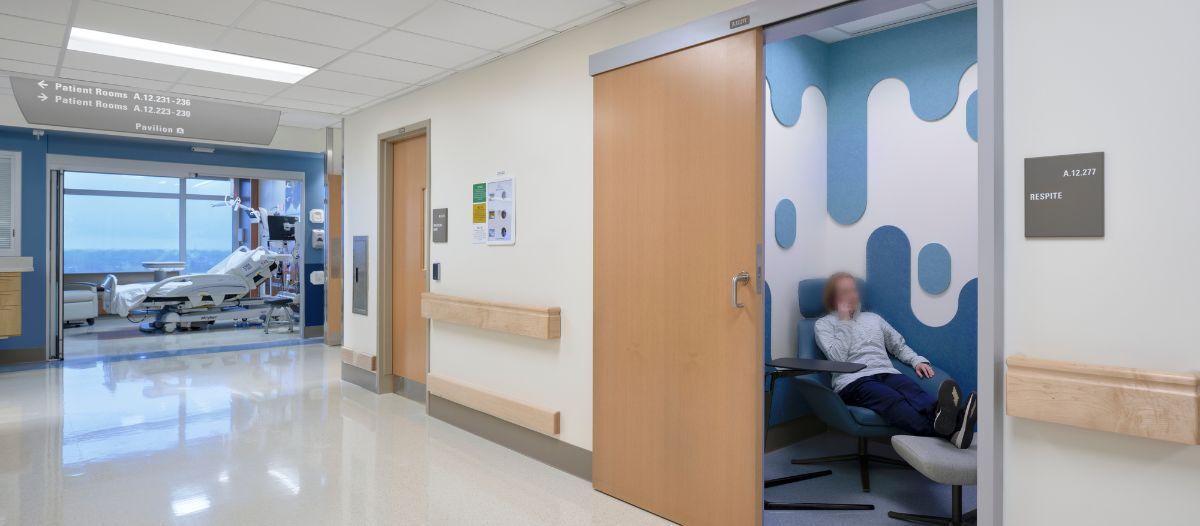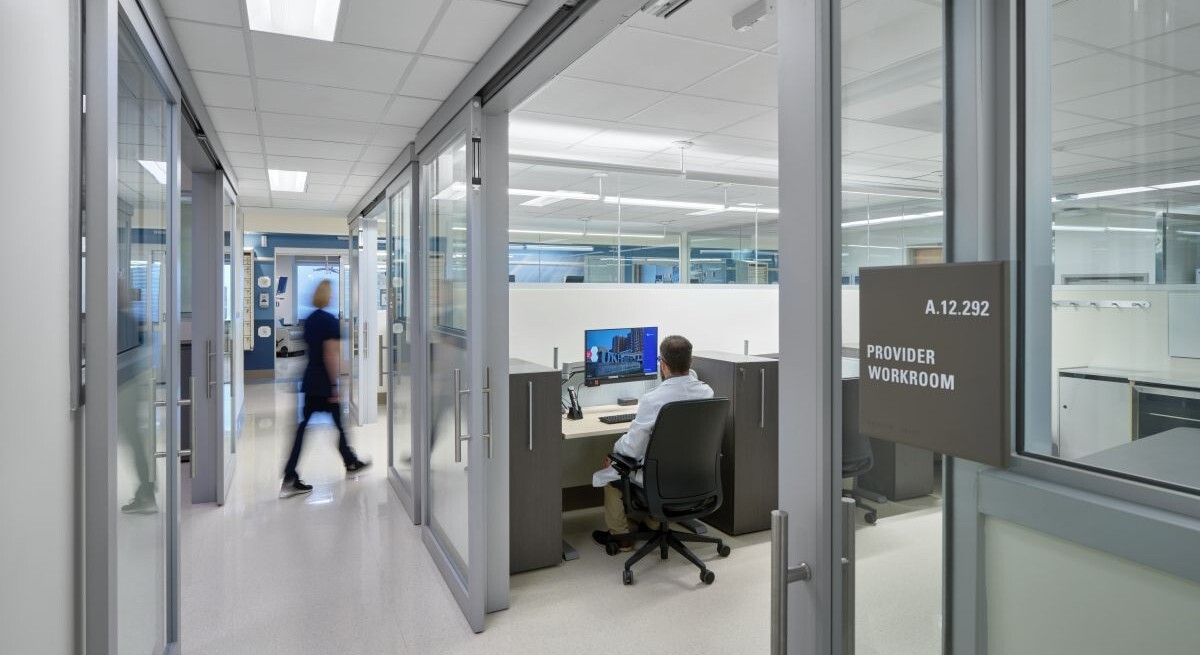Designed to Succeed
How flexible openings solve several challenges simultaneously

Modern health care settings are often celebrated for their cutting-edge equipment and patient-focused floor plans. While these elements are important, they would be completely unusable if the facilities did not have interior doors or were equipped with ones that did not meet code requirements. That said, interior doors are rarely discussed after a facility has opened, which can further add to the complications around their specification.
These pieces of the architectural puzzle are not only some of the more difficult systems to design and specify, but they also repeat throughout a building — sometimes up to 300 doors per location. Because there can be so many units within a single facility, doors systems have the potential to significantly impact the cost of construction, the functionality of a space and the experience patients and providers have within it.
When used within medical centers, doors and their hardware must create accessible spaces that allow egress and meet life safety and other code-driven requirements. They may also be called on to contribute to project goals such as space-efficient and flexible designs, improved indoor air quality (IAQ), compliance with Health Insurance Portability and Accountability Act (HIPAA) guidelines and even enhanced security. These complex, and sometimes contradictory, considerations can be difficult to navigate and may result in specifications that must be redone to achieve code compliance or work against an occupant-centered interior.
Often, flexible openings are key to consider, as they can deliver a high degree of value to a project by solving several design and functionality challenges at once. But to maximize the potential of flexible openings, it is important for facility managers and specifiers to know the model codes and guidelines that influence health care design as well as the specific performance capabilities these door systems provide within the built environment.
Achieving code compliance depends on building type and location
Interior doors must meet model code requirements and comply with Americans with Disability Act (ADA) standards. But achieving code compliance can be confusing given each state chooses which codes and editions to adopt and amend as necessary. Specifiers are encouraged to confirm with a local authority having jurisdiction (AHJ) the code and edition in use at project’s location as well as any significant amendments to this code.
In general, states base their codes on the models developed by the National Fire Protection Association (NFPA) or those from the International Code Council (ICC). While requirements from both coding organizations often overlap, there are differences between them. Focusing on NFPA models, most door requirements are meant to preserve free egress during a fire or life safety emergency.
For door specification, the NFPA 101®, Life Safety Code®, is the most relevant. It is important to note that a medical facility in this model code can fall within four general categories, all of which have their own requirements and allowed exemptions to certain rules. That said, in general, doors must meet various sizing and operational criteria, especially if they are located along paths of egress. This can include hardware that requires no more than one releasing action as well as systems that do not need more than 30 pounds of force (lbf) to set the door in motion and no more than 15 lbf to open the door. When these doors are in fire-rated walls, they must also meet fire door assembly criteria that is relative to the walls in which they are installed.
Operation type may also be a deciding factor when it comes to door specification. NFPA 101 requires rooms with a calculated occupant load of more than 10 people to have at least one door that swings out in the direction of egress. Likewise, there may be more requirements for corridors that require hardware that uses accessible latching devices.

Planning accessible spaces through ADA standards
In addition to meeting requirements from the ICC and NFPA, interior doors must also meet ADA accessibility requirements. These include minimum opening widths, which is usually 32 inches when fully open, and hardware that does not require tight grasping, pinching or twisting of the wrist. ADA-compliant doors must also be operable with one hand, and their hardware needs to be located between 34 and 48 inches above the floor. Finally, door specification must also take maneuvering clearance into consideration to ensure a room is accessible for those using mobility assistive devices like wheelchairs. For example, the front approach maneuvering clearance from a door’s pull-side needs to be at least 18 inches, though 24 inches is preferred. The ADA explains other approach requirements in section 4.13 of the standards.
While this overview of ADA details many of the requirements for code-compliant door specification, it is not exhaustive and does not explain the exemptions to these codes. As such, building and facility professionals are encouraged to check the codes governing a project’s location and consult with an AHJ for clarification when necessary.
Further, it is important to note that these codes represent minimum requirements. There may be instances where doors that extend beyond these numbers and considerations would be advantageous to a design — for example, a space may benefit from the flexibility provided by an opening that is larger than 32 inches. In such a case, a door with an opening width that exceeds the minimum measurements would still be code-compliant, provided it also fulfills other requirements.
Solving building challenges with flexible openings
If specifiers were only planning to meet the minimums outlined in the model codes and nothing else, then selecting a code-compliant door would be a straightforward process. But project use, occupant need and other design considerations often create tension with model codes. Designing for space-efficiency is a prime example — especially as health care construction costs continue to rise and medical facilities look to combine multiple specialties within the same facility.
Commercial sliding doors are a cost-effective way to maximize useable space within the built environment. These systems can save up to 30 square feet per door by eliminating swing arc trajectories. The architects behind the renovation of medical and cardiovascular intensive care units (ICUs) inside the University of Kentucky’s Albert B. Chandler Hospital realized that specifying code-compliant sliding doors throughout allowed a higher degree of programming without compromising room and hallway space.
Used for provider workstations, meeting rooms and respite areas, these doors are designed to meet ADA standards for opening and operation, including hardware that is easy and intuitive to use for a variety of abilities. Additionally, because these doors eliminated swing arcs, they helped designers more easily achieve ADA-compliant maneuvering clearances from all approaches without having to significantly change their designs. The doors were not required to meet fire door assembly criteria.
However, sometimes areas that require fire door assemblies are in proximity to openings that are non-fire-rated. For example, a hospital on the U.S. West Coast utilized on-stage/off-stage design to improve patient and staff experience. While the doors leading into the patient zones were not required to have a fire rating, those leading from the exam room to the corridors did. Under these circumstances, door similarity can help providers move easily between spaces as well as reduce routine cleaning and maintenance labor, since staff can treat both sets of doors similarly, depending on the extensiveness of the maintenance.
For this application and others like it, select door manufacturers have options for sliding doors that are tested to UL 10b fire door assembly standards and achieve fire ratings for up to 45 minutes. These assemblies not only block fire but also help stop the spread of smoke with perimeter which can also contribute to privacy and improved indoor air quality.
More than the minimum: Patient privacy, provider wellbeing & flexible openings
Maintaining interiors that meet HIPAA’s Privacy Rule does not fall entirely on doors. These guidelines often require a robust compliance program to ensure protected health information (PHI) is safeguarded from unauthorized disclosure. That said, soundproofing can be a viable option for reducing instances of disclosure. Soundproofing a room can be quite complex—requiring considerations for the ability of architectural systems to dampen sound as well as recommendations from speech intelligibility indexes, which measure the ability of a listener to distinguish words from sounds within a building.
However, openings are often the biggest challenge in soundproof design. Sliding doors with perimeter and drop-down seals have achieved Noise Isolation Class (NIC) ratings up to 39, meaning they can dampen up to 39 decibels in field applications. This rating satisfies most recommendations for limiting the intelligibility of words behind closed doors. It can also contribute to patient and provider areas that are more acoustically isolated.
For example, in the Albert B. Chandler Hospital’s ICU, the sliding door systems reduced alarm fatigue and improved conditions for concentrated work. Of the full-lite doors, Dr. Ashley Montgomery-Yates, Senior Vice Chair of Medicine at University of Kentucky, explains, “Creating a sound barrier to protect the healthcare providers as they communicated patient information was incredibly important for this project. But we also discovered that our staff and providers wanted the ICU space to feel more open and to have visible lines of slight to other spaces within the unit. These doors met both the visual and acoustic goals and have been a great addition to the unit.”
Optimizing functionality with multiple flexible opening door systems
Because code requirements can vary depending on occupancy type, room use and capacity, one type of door may not meet all the needs for a given space. This was a challenge for pediatric intensive care unit (PICU) at the Atrium Health Levine Children’s Hospital in Charlotte, N.C.
This space needed space-efficient openings that met requirements across multiple applications. The design team worked with the facilities staff to choose three flexible opening options. Vetted by the facilities team for consistency and ease of maintenance, a swing door with an auxiliary leaf was specified for the patient rooms. This allowed a wider opening when needed without requiring larger swing arcs for everyday use. The door system used for this project met Grade 1 standards from the Builders Hardware Manufacturers Association (BHMA), meaning it could withstand the wear and tear typical of this application.
For shared office spaces and documentation rooms, the teams selected two types of sliding doors to maximize opening width without sacrificing square footage to accommodate swing arc trajectories. Similar to the Albert B. Chandler Hospital’s ICU, these doors offer premium acoustic performance to limit noise transfer from adjacent areas, which helps medical professionals concentrate on work and reduces alarm fatigue. One sliding door system sits flush within the wall. This provides an ideal transition from corridor to room. This is incredibly important as minimum clear corridor widths must be maintained in the areas where this sliding door system was specified.
Specifying three types of door systems within a single floor could potentially cause construction delays and result in an interior without visual cohesion. Likewise, it could complicate routine upkeep and maintenance. The teams working on the Atrium PICU sidelined these issues by working with a manufacturer that could provide multiple flexible opening door systems, streamlining specification and simplifying maintenance.
Flexible openings: One solution to many challenges
Selecting code-compliant doors within health care settings does not have to come with compromise. Flexible openings, such as sliding doors and swing doors with auxiliary leaves, can meet code-driven standards while also saving useable square footage by reducing swing arc trajectories. This feature also supports accessibility by helping openings more easily meet maneuvering requirements listed in the ADA standards.
When facility management teams have a better understanding of code requirements, functionality goals and door options, they can take a more active role in the design process, ensuring their facilities are designed to keep patients and staff safe while also supporting medical professionals’ ability to provide a high level of care.
While not required, space-efficient and flexible designs not only help medical centers more readily meet patient and provider needs in the present, but they also allow facilities to adapt to technological advances and unforeseen circumstances to ensure the long-term viability of a building. As a result, they can help reduce the total life-cycle cost of a facility. Knowing the multiple value points of flexible openings can help project teams solve several challenges in health care design.

Tysen Gannon, LEED AP, AD Systems has more than 15 years of experience in the architectural products industry, including roles in sales, product management, research and marketing, with a focus on glass and glazing, fenestration and façade systems.
Read more on Operations & Maintenance , Occupancy & Human Factors and Risk Management or related topics Planning and Design , Project Management and Operations and Maintenance Planning
Explore All FMJ Topics









